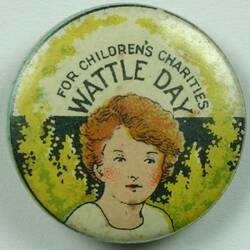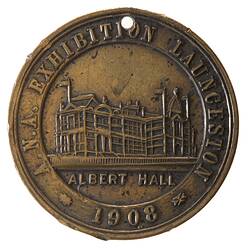Summary
Alternative Name(s): Button
'Wattle Day for Children' badge featuring branches of wattle and a lyrebird. Manufactured by A. W. Patrick, North Fitzroy, Melbourne, in 1933.
The first 'national' Wattle Day was celebrated in Sydney, Melbourne and Adelaide on 1 September 1910. Wattle had become a symbol of Australia with the approach of Federation. It was particularly promoted by the Australian Natives' Association, established in Melbourne in 1871 as a non-partisan and non-sectarian friendly society for Australian-born, white men seeking to shape Australia's nationhood and identity. The ANA was a strong advocate for Federation and became an advocate for White Australia. It was a staunch supporter of trade protection and immigration restriction, and Prime Minister Alfred Deakin was a member. Public support for Wattle Day peaked during World War I, when it was a potent symbol of home for military personnel serving overseas, and a means of raising money for organisations such as the Red Cross. Beautifully designed Wattle Day badges as well as wattle sprigs were sold. The influence of Wattle Day waned as the 20th century progressed, but in 1992 the Governor-General declared 1 September National Wattle Day.
Physical Description
Circular pressed metal badge with a plastic cover on the obverse, a metal back, and an attached pin. Text and an illustration in blue, light blue, yellow, brown and black ink appears on the obverse. In the centre, a lyrebird stands on grass, flanked on either side by a branch of wattle. This scene is enclosed within a light blue circular border containing printed text, and another border in blue ink on the rim. Off-white text appears on the bottom rim of the badge, within the outer blue border. The badge is discoloured and soiled. The reverse of the badge is tarnished, and the original silver colour has partly worn away.
More Information
-
Collection Names
-
Collecting Areas
-
Acquisition Information
Donation from Mrs Betty Laurie, by Dec 1986
-
Manufacturer
A.W. Patrick, Melbourne, Greater Melbourne, Victoria, Australia, 1933
-
Organiser of Event
Australian Natives' Association (ANA), Australia, post 1871
Wattle Day was an initiative of the Australian Natives Association (ANA) and the Wattle Blossom League. -
Organiser of Event
Wattle Blossom League, Australia, post 1889
Wattle Day was an initiative of the Australian Natives Association (ANA) and the Wattle Blossom League. -
Place & Date Used
-
Inscriptions
Printed: WATTLE DAY FOR CHILDREN/ 1933; A. W. Patrick Maker. 440 Rae ST. N.Fitzroy Melb[obscured]
-
Classification
-
Category
-
Discipline
-
Type of item
-
Overall Dimensions
5 mm (Depth), 23 mm (Outside Diameter)
-
Dimensions
4 mm (Depth), 22 mm (Outside Diameter)
Measurement From Conservation.
-
Keywords


